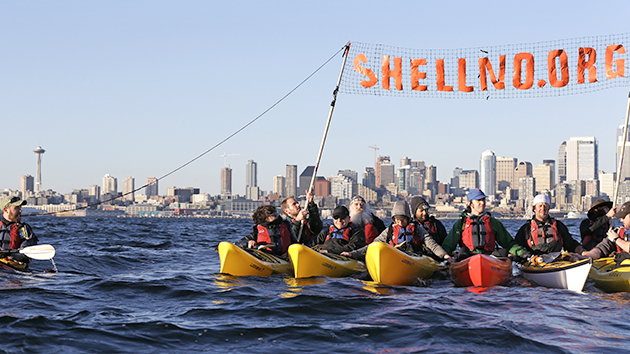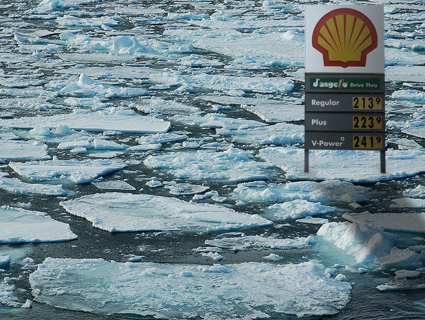
Kayaktavists gather to protest the Polar Pioneer, Shell's artic oil drilling rig stationed in the Port of Seattle. Greenpeace
This article is being updated as news breaks. See below for the latest.
Seattleites took a dramatic stand, er paddle, against Arctic oil drilling on Saturday afternoon. Against the backdrop of the Pacific Northwest city’s skyline, around 200 activists, local Native Americans, and concerned citizens took to kayak and canoe and surrounded a giant, Arctic-bound Royal Dutch Shell oil drilling rig currently making a layover in the Port of Seattle.
Despite the oil giant’s rocky history in the Arctic region, last Monday the Obama administration conditionally approved Shell’s summer plans to drill for oil in the Chukchi Sea, north of Alaska. Environmentalists are not happy, and neither are many in Seattle, whose port has become a home base for the two Shell oil rigs’ operations. The Port of Seattle’s commissioners took heat for their controversial decision to lease one of its piers to Shell, tying the progressive city to fossil fuel extraction and the potential for environmental catastrophe in the Arctic.
As the first of the towering oil rigs arrived in Elliott Bay late last week, a group of “activists, artists, and noisemakers” calling themselves ShellNo organized a series of protests to welcome the oil company. The “Paddle in Seattle” yesterday drew an impressive flotilla of kayaks, canoes, and boats into the Duwamish River, which feeds into the Elliott Bay, to surround the Coast-Guard-protected rig. Below is a roundup of Tweeted pictures taken by people on the scene:
‘Paddle in #Seattle’ protesters gather against #Shell oil rig. (Mark Harrison / ST) Story: http://t.co/glrr6C8cit pic.twitter.com/u3tJIgm2Hv
— Seattle Times Photo (@SeaTimesPhoto) May 16, 2015
#PaddleInSeattle #ShellNo pic.twitter.com/xfonuonQMJ
— Sydney Brownstone (@sydbrownstone) May 16, 2015
#ShellNo https://t.co/9M5DAePrsz
— Ansel (@Ansel) May 16, 2015
PHOTOS: Anti-Arctic drilling activists hold #ShellNo protest in Seattle – http://t.co/gZgUZ6XBtb pic.twitter.com/6i7oYW6cTp
— KOMO News (@komonews) May 16, 2015
PHOTOS: Anti-Arctic drilling activists hold #ShellNo protest in Seattle – http://t.co/gZgUZ6XBtb pic.twitter.com/tQpHnlaS2L
— KOMO News (@komonews) May 16, 2015
Amazing pictures of the Duwamish tribe leading the #shellno flotilla in Seattle’s harbor #PaddleInSeattle pic.twitter.com/E2ep8JFh6c
— Bill McKibben (@billmckibben) May 16, 2015
Today’s best banner. pic.twitter.com/QBacS1aO6w
— Ansel (@Ansel) May 16, 2015
Seattle’s true polar pioneer. pic.twitter.com/Rw7VnyEq4x
— Ansel (@Ansel) May 16, 2015
The sign says “climate justice now” – protestors are chanting “shell no” pic.twitter.com/o7WvNLMLmN
— Coral Garnick (@CoralGarnick) May 16, 2015
Tribal canoes are intermixed with the kayakers and other boats participating in the #paddleinseattle pic.twitter.com/mQYp1M94Te
— Coral Garnick (@CoralGarnick) May 16, 2015
UPDATE, Monday, May 18, 2:00 p.m. PST:
Today, “ShellNo” continued its protest of Shell’s plans to drill for oil in the arctic by blocking the entrances to the Port of Seattle’s Pier 5 where one of the oil company’s rigs is docked. Hundreds gathered earlier this morning at the pier’s main entrance to slow operations on the rig, although some rig workers were apparently able to get in through other entrances. Police did not interfere with the demonstration, and at about 1:30PM the group began to leave the pier and march back the way they came. Those present included Native American activists and Seattle City Council member Kshama Sawant. Some pictures of the event:
Mohawk Kuzma is among the #BlackLivesMatter, Filipino and indigenous activists leading this march. #ShellNo pic.twitter.com/8tGx7GgNTT
— Ansel (@Ansel) May 18, 2015
Who said blockades need to be boring? We’ve got amazing speakers and musicians keeping the crowd pumped. #ShellNo pic.twitter.com/rvb6DAUDk6
— Oil Change Intl (@PriceofOil) May 18, 2015
With elected leadership having failed us, we launch a movement of non-violent civil disobedience to say #ShellNo! https://t.co/ZkCgfpe4Te
— Kshama Sawant (@cmkshama) May 18, 2015
The scene at the Port of Seattle’s Terminal 5. #ShellNo pic.twitter.com/g126LCaVEY
— Ansel (@Ansel) May 18, 2015
SHELL NO: Seattle protesters block entrance to port where Shell’s oil rig is moored http://t.co/HKQJ1zbD6D #ShellNo pic.twitter.com/hQZLkd0daD
— Earthjustice (@Earthjustice) May 18, 2015
Protestors at Terminal 5 have decided to end #Shellno protest and march back to morning starting point pic.twitter.com/uSKZk6Vpa0
— Hal Bernton (@hbernton) May 18, 2015















